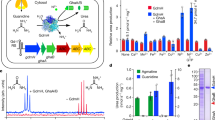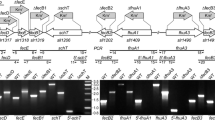Abstract
Biosynthesis of glycine betaine from simple carbon sources as compatible solute is rare among aerobic heterotrophic eubacteria, and appears to be almost exclusive to the non-halophilic and slightly halophilic phototrophic cyanobacteria. Although Synechococcus sp. WH8102 (CCMP2370), a unicellular marine cyanobacterium, could grow up to additional 2.5% (w/v) NaCl in SN medium, natural abundance 13C nuclear magnetic resonance spectroscopy identified glycine betaine as its major compatible solute. Intracellular glycine betaine concentrations were dependent on the osmolarity of the growth medium over the range up to additional 2% NaCl in SN medium, increasing from 6.8 ± 1.5 to 62.3 ± 5.5 mg/g dw. The ORFs SYNW1914 and SYNW1913 from Synechococcus sp. WH8102 were found as the homologous genes coding for glycine sarcosine N-methyltransferase and sarcosine dimethylglycine N-methyltransferase, heterologously over-expressed respectively as soluble fraction in Escherichia coli BL21(DE3)pLysS and purified by Ni-NTA His•bind resins. Their substrate specificities and the values of the kinetic parameters were determined by TLC and 1H NMR spectroscopy. RT-PCR analysis revealed that the two ORFs were both transcribed in cells of Synechococcus sp. WH8102 growing in SN medium without additional NaCl, which confirmed the pathway of de novo synthesizing betaine from glycine existing in these marine cyanobacteria.








Similar content being viewed by others
Abbreviations
- GSDMT:
-
Glycine–sarcosine–dimethylglycine methyltransferase
- GSMT:
-
Glycine sarcosine methyltransferase
- SDMT:
-
Sarcosine–dimethylglycine methyltransferase
- DMT:
-
N,N-dimethylglycine methyltransferase
- GNMT:
-
Glycine N-methyltransferase
- PEAMT:
-
Phosphoethanolamine N-methyltransferase
- AhGSMT:
-
Aphanothece halophytica GSMT
- AhDMT:
-
Aphanothece halophytica DMT
- AdoMet:
-
S-Adenosylmethionine
- dw:
-
Dry weight
- ORF:
-
Open reading frame
- CV:
-
Column volumes
References
Altschul SF, Gish W, Miller W, Myers EW, Lipman DJ (1990) Basic local alignment search tool. J Mol Biol 215:403–410
Brahamsha B (1996) A genetic manipulation system for oceanic cyanobacteria of the genus Synechococcus. Appl Environ Microbiol 62:1747–1751
Chen YM, Chen LY, Wong FH, Lee CM, Chang TJ, Yang-Feng TL (2000) Genomic structure, expression, and chromosomal localization of the human glycine N-methyltransferase gene. Genomics 66:43–47
Desplats P, Folco E, Salerno GL (2005) Sucrose may play an additional role to that of an osmolyte in Synechocystis sp. PCC 6803 salt-shocked cells. Plant Physi Biochem 43:133–138
Dufresne A, Garczarek L, Partensky F (2005) Accelerated evolution associated with genome reduction in a free-living prokaryote. Genome Biol 6(R14):1–9
Gadda G, McAllister-Wilkins EE (2003) Cloning, expression, and purification of choline dehydrogenase from the moderate halophile Halomonas elongata. Appl Environ Microbiol 69:2126–2132
Galinski EA, Trüper HG (1982) Betaine, a compatible solute in the extremely halophilic phototrophic bacterium Ectothiorhodospira halochloris. FEMS Microbiol Lett 13:357–360
Grieve CM, Grattan SR (1983) Rapid assay for determination of water soluble quaternary ammonium compounds. Plant and Soil 70:303–307
Imhoff JF, Rodriguez-Valera F (1984) Betaine is the main compatible solute of halophilic eubacteria. J Bacteriol 160:478–479
Incharoensakdi A, Wutipraditkul N (1999) Accumulation of glycine betaine and its synthesis from radioactive precursors under salt-stress in the cyanobacterium Aphanothece halophytica. J Appl Phycol 11:515–523
Kumar S, Tamura K, Nei M (2004) MEGA3: Integrated software for Molecular Evolutionary Genetics Analysis and sequence alignment. Briefings in Bioinformatics 5:150–163
Ladas NP, Papageorgiou GC (2000) Cell turgor: a critical factor for the proliferation of cyanobacteria at unfavorable salinity. Photosynth Res 65:155–164
Lai MC, Yang DR, Chuang MJ (1999) Regulatory factors associated with synthesis of the osmolyte glycine betaine in the halophilic methanoarchaeon Methanohalophilus portucalensis. Appl Environ Microbiol 65:828–833
Lee MB, Blunt JW, Lever M, George PM (2004) A nuclear-magnetic-resonance-based assay for betaine-homocysteine methyltransferase activity. Anal Biochem 330:199–205
Mackay MA, Norton RS, Borowitzka LJ (1983) Marine blue-green algae have a unique osmoregulatory system. Mari Biol 73:301–307
Mackay MA, Norton RS, Borowitzka LJ (1984) Organic osmoregulatory solutes in cyanobacteria. J Gen Microbiol 130:2177–2191
Martins LO, Santos H (1995) Accumulation of mannosylglycerate and di-myo-inositol-phosphate by Pyrococcus furiosus in response to salinity and temperature. Appl Environ Microbiol 61:3299–3303
Muhling M, Fuller NJ, Millard A, Somerfield PJ, Marie D, Wilson WH, Scanlan DJ, Post AF, Joint I, Mann NH (2005) Genetic diversity of marine Synechococcus and co-occurring cyanophage communities: evidence for viral control of phytoplankton. Environ Microbiol 7:499–508
Nicholas KB, Nicholas HB (1997) GeneDoc: a tool for editing and annotating multiple sequence alignment. Distributed by the authors
Nuccio ML, Rhodes D, McNeil SD, Hanson AD (1999) Metabolic engineering of plants for osmotic stress resistance. Curr Opin Plant Biol 2:128–134
Nyyssölä A, Kerovuo J, Kaukinen P, von Weymarn N, Reinikainen T (2000) Extreme halophiles synthesize betaine from glycine by methylation. J Biol Chem 275:22196–22201
Nyyssölä A, Reinikainen T, Leisola M (2001) Characterization of glycine sarcosine N-methyltransferase and sarcosine dimethylglycine N-methyltransferase. Appl Environ Microbiol 67:2044–2050
Oren A (1999) Bioenergenetic aspects of halophilism. Microbiol Mol Biol Rev 63:334–348
Palenik B, Brahamsha B, Larimer FW, Land M, Hauser L, Chain P, Lamerdin J, Regala W, Allen EE, McCarren J, Paulsen I, Dufresne A, Partensky F, Webb EA, Waterbury J (2003) The genome of a motile marine Synechococcus. Nature 424:1037–1042
Partensky F, Hess WR, Vaulot D (1999) Prochlorococcus, a marine photosynthetic prokaryote of global significance. Microbiol Mol Biol Rev 63:106–127
Peter H, Bader A, Burkovski A, Lambert C, Kramer R (1997) Isolation of the putP gene of Corynebacterium glutamicum and characterization of a low-affinity uptake system for compatible solutes. Arch Microbiol 168:143–151
Reed RH, Chudek JA, Foster R, Stewart WDP (1984a) Osmotic adjustment in cyanobacteria from hypersaline environments. Arch Microbiol 138:333–337
Reed RH, Richardson DL, Warr SRC, Stewart WDP (1984b) Carbohydrate accumulation and osmotic stress in cyanobacteria. J Gen Microbiol 130:1–4
Reed RH, Stewart WDP (1985) Osmotic adjustment and organic solute accumulation in unicellular cyanobacteria from freshwater and marine habitats. Mari Biol 88:1–9
Reed RH, Borowitzka LJ, Mackay MA, Chudek J.A, Foster R, Warr SCR, Moore DJ, Stewart WDP (1986) Organic solute accumulation in osmotically stressed cyanobacteria. FEMS Microbiol Rev 39:51–56
Rocap G, Larimer FW, Lamerdin J, Malfatti S, Chain P, Ahlgren NA, Arellano A, Coleman M, Hauser L, Hess WR, et al. (2003) Genome divergence in two Prochlorococcus ecotypes reflects oceanic niche differentiation. Nature 424:1042–1047
Sambrook J, Fritsch EF, Maniatis T (1989) Molecular cloning: a laboratory manual, 2nd edn. Cold Spring Harbor Laboratory Press, Cold Spring Harbor, NY
Scanlan DJ (2003) Physiological diversity and niche adaptation in marine Synechococcus. Adv Microb Physiol 47:1–64
Severin J, Wohlfarth A, Galinski EA (1992) The predominant role of recently discovered tetrahydropyrimidines for the osmoadaptation of halophilic eubacteria. J Gen Microbiol 138:1629–1638
Sibley MH, Yopp JH (1987) Regulation of S-adenosylhomocysteine hydrolase in the halophilic cyanobacterium Aphanothece halophytica: a possible role in glycine betaine biosynthesis. Arch Microbiol 149:43–46
Thompson JD, Gibson TJ, Plewniak F, Jeanmougin F, Higgins DG (1997) The Clustal X windows interface: flexible strategies for multiple sequence alignment aided by quality analysis tools. Nucl Acids Res 24:4876–4882
Waditee R, Tanaka Y, Aoki K, Hibino T, Jikuya H, Takano J, Takabe T, Takabe T (2003) Isolation and functional characterization of N-methyltransferases that catalyze betaine synthesis from glycine in a halotolerant photosynthetic organism Aphanothece halophytica. J Biol Chem 278:4932–4942
Waterbury JB, Watson S W, Valois FW, Franks DG (1986) Biological and ecological characterization of the marine unicellular cyanobacterium Synechococcus. Can Bull Fish Aquat Sci 214:71–120
Acknowledgments
This work was supported by the Postdoctoral Grant of Ocean University of China to Wei-Dong Lu. We wish to thank the editors and anonymous reviewers for their valuable suggestions and comments. We also thank CCMP for sharing the strains, Dr. Tracey Riggens (CCMP, USA) for many useful advices on the early stage of reviving the culture, and Bo Zhang (China Agricultural University) for giving much help during the experiment.
Author information
Authors and Affiliations
Corresponding author
Rights and permissions
About this article
Cite this article
Lu, WD., Chi, ZM. & Su, CD. Identification of glycine betaine as compatible solute in Synechococcus sp. WH8102 and characterization of its N-methyltransferase genes involved in betaine synthesis. Arch Microbiol 186, 495–506 (2006). https://doi.org/10.1007/s00203-006-0167-8
Received:
Revised:
Accepted:
Published:
Issue Date:
DOI: https://doi.org/10.1007/s00203-006-0167-8




